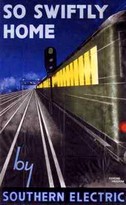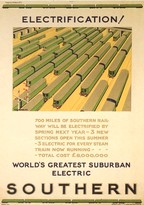 |
| |
    
|
| |
      
|
| |
|
SOUTHERN
ELECTRICS
(1928
- 1986)
|
|
| |
ELECTRIFICATION SPARKS
OFF CHANGES
|
| |
| With the
third rail electrification entering service on the Epsom
Downs branch on 17th June 1928, a new era was taking shape
for the Epsom Downs branch. |
| |
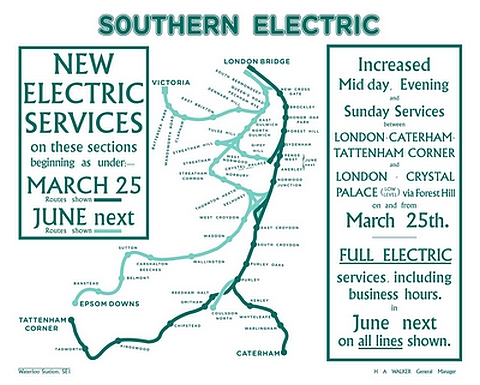
|
|
Whilst the reason for building
the line - horse racing - was still of some
importance at that time, with Pullman, first
class and Lord Derby's specials continuing to use
Epsom Downs until 1939 (and Pullmans and first
class specials resumed after the war until 1953
[Kirkby, 1983]), it was already becoming quite
clear that commuters would soon become the main
source of income for the Epsom Downs branch. Nearly four million houses were
built in England between 1919 and 1939, the vast
majority of which (nearly three million) were
built in the growing areas of suburbia and
offered for sale, not rent. The number of
owner-occupied houses in Britain thus soared from
around 750,000 in the early 1920s to more than
3,250,000 by 1938 (Gardiner, 2010).
The countryside along
the Epsom Downs branch was part of this
development too, and saw an increasingly
intensive building activity which transformed it
into a residential area.
|
|
| |
| In 1927, the line had seen the
purchase of 3,000 season tickets - by 1933, this
figure had grown to 13,000 and was still rising
(Kirkby, 1983). The coming of the Southern
Electrics not only heralded a change in
appearance of the traffic on the line, but the
traffic itself was, in fact, changing. As of
1928, platforms at Belmont and Banstead were
extended accordingly to accomodate 8-car trains
(Kirkby, 1983), increasing the number of
available seats to the rising number of daily
passengers travelling on the trains.
The Southern Railway -
created on January 1st 1923 by
the amalgamation of the LB&SCR, LSWR and
SE&CR as set out by the Railway Act of 1921 -
had a policy of actively encouraging people to
consider moving to such newly developed housing
estates, and whilst its poster proclaiming that
you could "live in Kent and be
content" is no doubt the best known,
the SR's advertising department also put out the
slogan "live in Surrey and be
happy".
Other advertisment
campaigns highlighted the efficiency and
cleanliness of its electric multiple-units in
comparison to steam, as well as the frequency of
its services to and from London. The housing boom
created huge numbers of commuters, and in the
years preceding World War II, the railway almost
had a monopoly in handling that traffic.
|
|
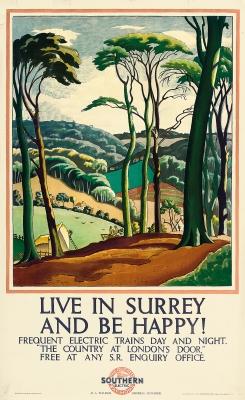 |
|
| |
|
3SUB on a Victoria to Epsom
Downs service pictured at Banstead in 1938 (Lens of Sutton)
|
| |
| The
originally AC overhead service between Sutton and
Victoria was converted to third rail during 1929 and
officially opened on 6th July 1930, from which date
trains also ran to and from Epsom Downs, giving commuters
a further choice of destination in the City by travelling
either to London Bridge (as before) or London Victoria.
With the introduction of the EMU service on the line,
Epsom Downs became a motorman's signing-on point, and the
abundance of platforms was put to use by stabling
electric stock overnight. In 1938, for example, six 8-car
trains were stabled overnight and seven 3-car sets and
six 2-car trailers were stabled between the morning and
evening peaks (Kirkby, 1983) |
| |
WAR ON THE LINE
During
the Second World War, the proximity to London exposed the
railway line to numerous air attacks as the region around
Epsom Downs was under constant pounding of the Blitz
throughout 1940/1941, as R. T. A. Northrop, a
local resident, noted in his diary on 4 November 1940.
"Last night was the first time
for 57 nights when no air raid warning sounded. It
seemed unreal. Bad weather seems to have caused this
happy happening. Going to Epsom Downs station
everything seemed peaceful and beautiful except for
the bomb craters and heaps of chalk. I still arrive
in London about 11.00 a.m. and leave about 3.30 p.m.
The service is much better now and I arrive home
about 5.30 p.m. in time to put up the black out and
have tea before the air raid warning sounded. The
weather was still bad but plenty of planes seemed to
go towards London. One dropped 6 bombs nearby. We
heard them whistle down."
By early 1941, Surrey
County Council’s War Emergency Committee had
launched the construction of deep tunnel shelters, often
close to railway stations, and two of these were dug near
Epsom Downs (Harp, AN).
Although
the damage caused to the railway branch was limited to a
smaller number of actual incidents, it was nevertheless
substantial: on 15th April 1941 a bomb destroyed the original
Belmont station building (along with the California Inn
across the road, which had been responsible for the
station originally being named California), killing 10
people and injuring many more (Edwards, 1959).
In
July 1941 the railway line suffered another direct hit
when a high explosive bomb fell onto the tracks close to
the Epsom Downs end of Banstead station and the resulting
debris formed of lengths of rail and wooden sleepers hit
and damaged numerous houses in the vicinity.
During
the war, Epsom Downs also saw the stabling of non-regular
stock - according to SR and Ministry of War Transport
records, a V1 bomb damaged 10 Pullman coaches stored
there on July 19th 1944.
|
| |
DECLINE OF TRAFFIC
Whilst
the service pattern introduced in the early 1930s (with
trains running at 20-minute intervals peak and 30-minute
intervals off-peak) basically lasted well into the 1960s,
the growth of the commuter traffic demanded additional
trains from London Bridge to Epsom Downs (Kirkby, 1983).
The numerical headcodes for the routes served were
"39" (London Bridge - Epsom Downs via West
Croydon), "84" (Victoria - Epsom Downs via West
Croydon) and "0" (Victoria - Epsom Downs via
Mitcham Junction).
The
introduction of the five-day business week in 1958,
however, quickly reduced Saturday services to two trains
per hour on each route, and regular off-peak services
started to attract notably fewer passengers.
|
| |
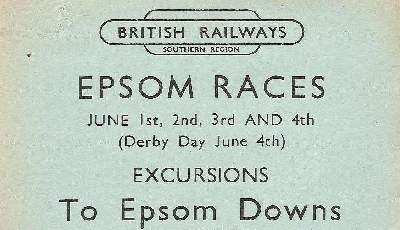
1949
handbill (personal collection)
|
|
Special
and excursion trains to the Derby were still run
to Epsom Downs by Southern Electric in BR days
(this example handbill dates from 1949), and on
Derby Day 1952, a total of 202 trains were run to
Epsom Downs - and over half of these trains were
run between 11am and 7pm. All trains were formed
of two four-car suburban third class units, with
the exception of the first passenger in each
direction, formed of one unit only, and the
Pullman and first class special (hauled by
electric locomotive #20003), which left Victoria
at 12.35pm and returned from Epsom Downs at
5.40pm, using platform 6. Congestion at the
regular booking office resulted in a temporary
facility set up outside the station building.
Once the event was over and passengers had made
their way back home, the normal staff contingent
remained: one signalman, one porter, and one
carriage cleaner (Skinner, 1952). |
|
| |
| Just as
people living in the Greater London area had expanded
their living space in the housing boom of the 1920s and
1930s, they were now extending their individual mobility
beyond the means and offerings of public transport.
Whilst only 15% of all households in Britain owned a
private car in 1951, that figure rose to 25% within the
next ten years and climbed to almost 50% by 1971
(Leibling, 2008). Motor traffic used for the transport of
goods increased in even greater leaps and bounds, and the
closing of the goods yards at Banstead in 1964 and
Belmont in 1969 (which had still been served by steam
engines such a class C2Xs) effectively meant that the
line was now passenger-only. |
| |
| All of the
London suburban services were beginning to
require heavy subsidising, and government was
putting pressure on the railways for greater
economies accordingly. Major cut-backs on the
Epsom Downs services were introduced in 1961,
with most off-peak trains from London Bridge
terminating at Sutton. May 1969 saw the closing
of Epsom Downs as a motorman signing-on point
(Kirkby, 1983), and that same month Sunday
services ceased on the branch. The
platform and track layout at Epsom Downs had
always been a paradoxical affair. The great
bustling masses of travellers for which it had
once been built (and which had only travelled
here on a very limited number of days during the
year) were now beginning to fade even on Derby
days, and throughout the rest of the year the
station complex was oversized beyond description.
|
|
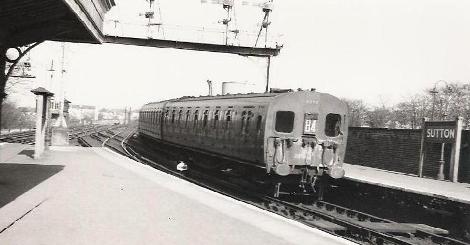
A 4SUB
Epsom Downs service at Sutton on 20th April 1958 (NN, personal
collection)
|
|
| |
| The resulting effect for the
(off-peak) passenger arriving at Epsom Downs station
could at times have been rather eerie. Possibly even
scarier for British Rail, however, was the prospect of
having to maintain and service such a large station
complex for seemingly no reason. Surprisingly,
the nine platform layout had not been cut before and
survived for as long as 1969, when finally all platforms
other than numbers 4 and 5 (which were renumbered as 1
and 2) were put out of use and the trackwork no longer in
use abandoned.
|
| |
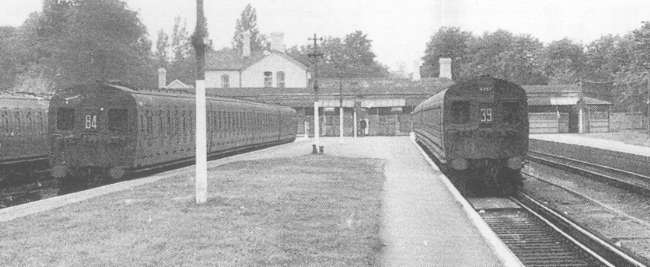
Epsom
Downs in October 1962 (Lens
of Sutton)
|
|
Eventually,
the now defunct segments of track would be lifted
and removed as the berthing of stock ceased on 1st May 1972 (Kirkby, 1983). The
broad platform structures with their grass
centers (built to handle exceptional numbers of
passengers getting off and on to trains at the
same time) were left in place.
For
years to come, the abandoned platforms at Epsom
Downs would be a silent reminder of what had once
been the reason for building the railway - in
days long gone since.
|
|
| |
MODERNISATION OF THE
BRANCH
Cutting back
the Epsom Downs branch's historic infrastructure also
included the introduction of colour light signalling and
track circuit block working as of 21st
December 1969. As a consequence, the signal boxes at
Banstead and Belmont were both abolished.
|
| |
| But even at
this point in its history, the station at Epsom
Downs remained an anomaly as the terminus itself
retained its signal box along with most of the
existing LB&SCR semaphore signals in spite of
the considerable reduction of tracks. 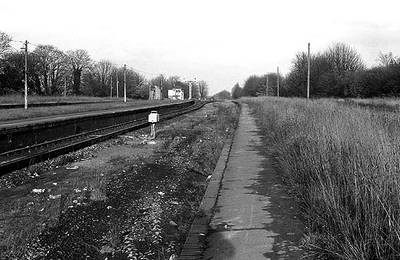
Epsom Downs
in November 1975, looking towards the signal box
(Nick Catford, used with kind permission,
courtesy of Subterranea Britannica's
Disused Stations website)
|
|
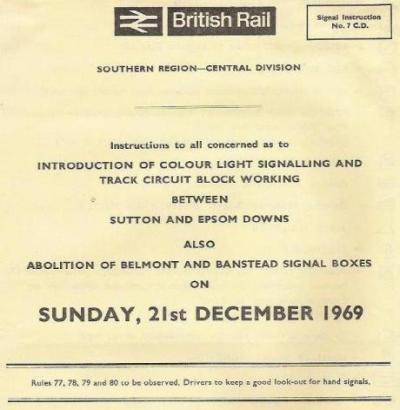
BR Signal
Instructions 1969 (personal collection)
|
|
| |
| Although
lamented by some, the 1969 modernisation measures helped
to shape the future of the branch as part of a working
railway rather than becoming a museum line - although
there seem to have been a few plans and ideas here and
there along the lines of the "Bluebell
Railway". The station layout at Epsom Downs would
undoubtedly have provided an ideal terminus with
sufficient storage siding capacities, but none of those
ideas seems to have reached the stage of actually finding
their way into any official papers, yet alone
consideration. Besides, commuter patronage was such that
there was no threat of closure, and so the line marched
stubbornly on through the difficult era of the 1970s into
the brave new world of the 1980s. |
| |
| The Saxby
& Farmer design signal box at Epsom Downs,
erected in 1879, was finally scheduled to close
in 1982 in connection with a general resignalling
scheme set up for the area which transferred
control to a centralised box (named Victoria even
though it was actually located at Clapham
Junction). However, the end came sooner - on the
night of 16th November 1981, Epsom Downs
signal box was destroyed by fire. This was an event which should
prove to affect the future appearance of the
Epsom Downs branch in a decisive manner.
The
most immediate effect was that there were no more
through trains on the branch from 26th November 1981 until 4th November 1982 as pilotman
working was implemented between Sutton and Epsom
Downs as an emergency measure. This allowed BR to
temporarily operate the line as a single dead-end
branch under the "one engine in steam"
rule.
This
resulted in a shuttle service between Epsom Downs
and Sutton, where all passengers were required to
alight and change to connecting trains. On some
occasions, this back and forth train service
between Sutton and Epsom Downs was operated by
preserved 4SUB unit 4732, restored to original
green livery and bringing back some original
Southern Electrics atmosphere to the line.
|
|
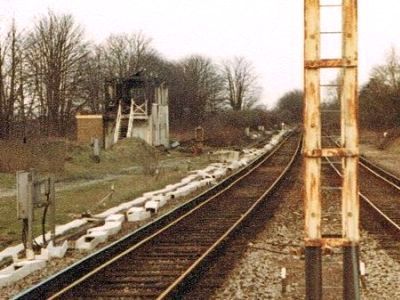
The
semi-destroyed Epsom Downs signal box as seen
from the platform end on 13th March 1982 (NN, personal
collection)
|
|
| |

Track and
signalling diagram at Epsom Downs as of 3rd October 1982 (BR Signal
Instructions, personal collection)
|
|
On 3rd October 1982, the inevitable
happened - the singling of the Epsom Downs
branchline beyond a point some 40 yards on the
Belmont side of Ventnor Road bridge, midway
between Sutton and Belmont. The
station layout at Epsom Downs retained its
previous layout with an island platform serving
two tracks as platforms 1 and 2. The rest of the
branch, however, underwent a radical change as
the former Up line was lifted throughout the
summer and autumn of 1982.
From
Ventnor Road bridge onwards, the line now became
a stretch of single track over the old Down line,
with centralised signalling controlled from the
electronic box at Victoria and signals on the
branch thus displaying numbers with the prefix
VC.
|
|
| |
| Perhaps the
planned general resignalling scheme would
eventually have had the same effect on the
branch, albeit not as quickly. And following the
precipitated pruning of the branch, an atmosphere
of growing disrepair started to befall many parts
of the line. In July 1987 (left), a Cl 455 EMU
travels through the cutting alongside the golf
course on Banstead Downs. Almost five years since
the Up line was lifted, scattered sleepers and
lifted track still indicate that this is not how
it used to be. Another ten years on, these
witnesses would all be gone - first hidden by
shrubs which ventured onto what once was a
trackbed, and then finally taken away.
Through
a chain of chance events, the Epsom Downs line
was now a modern, "functional" commuter
branchline. But there were even more and further
changes looming still.
|
|
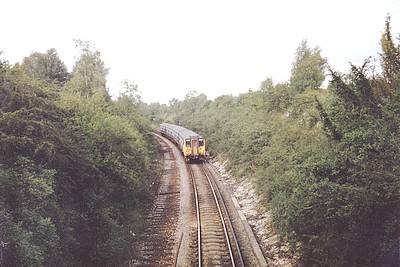 |
|
| |
|
Continue to Network SouthEast (1986-1994)
|
|
| |
SOURCES
EDWARDS Gareth
(1959) The Story of Belmont Hospital 1853-1959,
SP
GARDINER
Juliet (2010) The Thirties: An Intimate History of
Britain, Harper Press
HARP
Peter (AN) "Local
History – Banstead Air-Raid Shelters", Tattenham
& Preston Residents Association Website
KIRKBY
J.R.W. Kirkby (1983) The Banstead and Epsom Downs
Railway, Locomotion Papers Series, Oakwood Press
LEIBLING
David (2008) Car Ownership in Great Britain, RAC
Foundation for Motoring Publication
SKINNER
M.W.G. (1952) "Derby Day, 1952, at Epsom
Downs", Railway Magazine, August 1952 issue
|
| |
|
| |
Page last revised 12 October
2024
|

|



